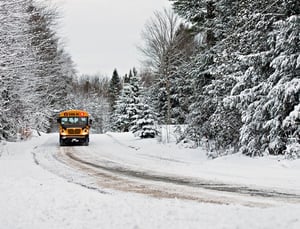Tips For Winter School Bus Fleet Maintenance
published on January 29, 2016 by Sonia Mastros
bus routing software, school bus fleet optimization, fleet maintenance, propane fueled buses
 As drivers around the country break out their snow tires, school district transportation departments are preparing buses for chilly temperatures. Ensuring that your fleet stays in tip-top shape during the winter months takes some effort and planning. Here are some tips for winter school bus fleet maintenance.
As drivers around the country break out their snow tires, school district transportation departments are preparing buses for chilly temperatures. Ensuring that your fleet stays in tip-top shape during the winter months takes some effort and planning. Here are some tips for winter school bus fleet maintenance.
Make Inspection a Priority
Taking the time to thoroughly inspect buses on a regular basis can significantly reduce problems causing buses to break down, especially during the winter months. Hoses, fan belts and all rubber parts should be inspected on a weekly basis. Electrical wiring and connections should also be checked for damage. Air cleaners and air inlets should be checked daily.
Practice Preventative Maintenance
Certain preventative measures can keep winter headaches from happening in the first place. When the weather turns cold, bus batteries should be kept fully charged and warm. Ensuring that fuel tanks stay full when engines will be shut off for over eight hours will prevent ice crystals and condensation from forming on exposed tank walls.
Transportation department employees should stay in close contact with local government officials to stay abreast of winter road maintenance plans and updates to cold weather emergency procedures. Drivers should also be trained to respond to the unique traffic situations that occur when snow falls. Snow drifts and slippery roads mean a higher risk of accidents, so drivers should be prepared to deal with the hazards of chilly weather.
Seek out Creative Solutions
During periods of extreme cold, diesel engines require different fuel grades. To prevent cold weather problems, some school districts are turning to alternative fuel. Utilizing propane fueled buses prevents the gelling issues that are experienced in diesel-powered fleets. Along with environmental benefits, it appears that propane-powered buses are ideal for winter temperatures.
Snow and sleet can lead to safety concerns and bus damage. Some districts avoid hazardous conditions by relying on technology. Bus routing software can help administrators determine which paths are most efficient and help drivers avoid hazardous conditions. Minimizing the amount of time that students spend outside in the cold is another factor to consider when planning safe winter routes.
For more tips on how to keep your school bus fleet optimized, reach out to our transportation experts at 866-740-8994 or click to chat with someone now.
How does your school district deal with fleet maintenance during the winter months? Please share your comments.






